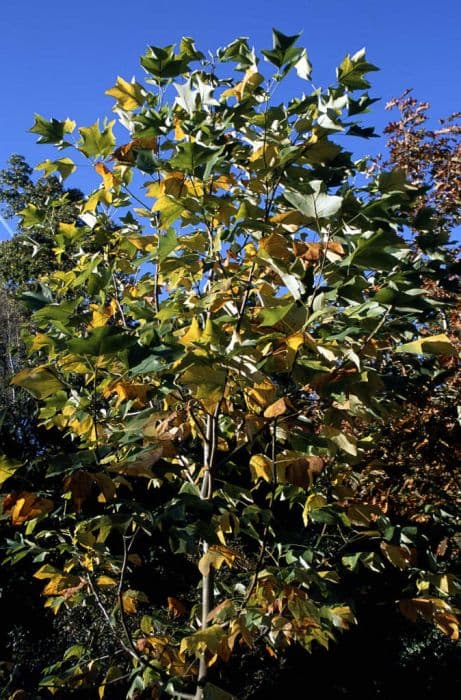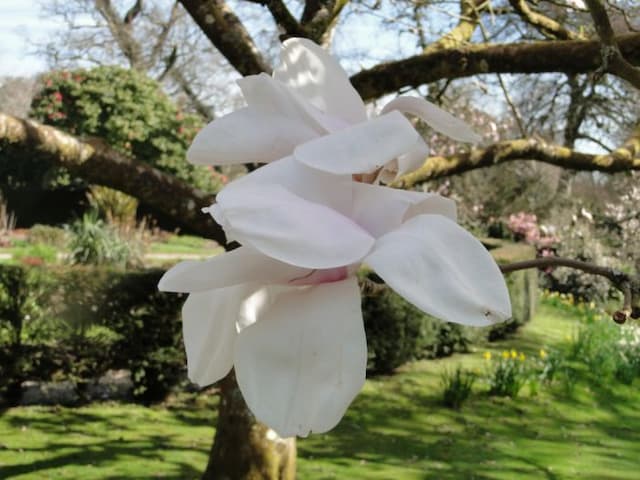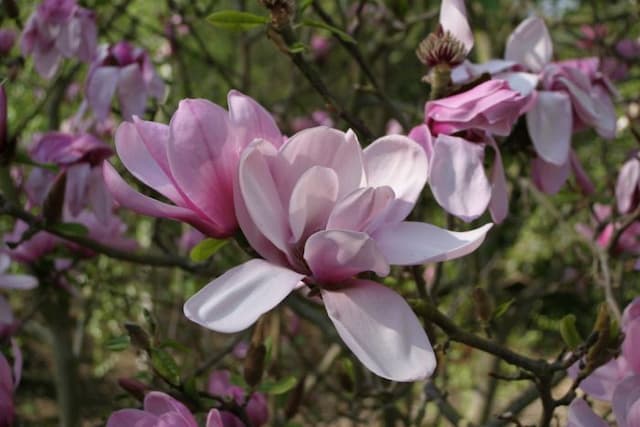Golden Pond Magnolia Magnolia 'Golden Pond'

ABOUT
Magnolia 'Golden Pond' is a captivating plant known for its distinctive flowers and elegant foliage. The crowning glory of this plant is its blooms. The flowers are large and showy, with a creamy yellow hue that seems to radiate warmth and sunshine. These cup-shaped blossoms often possess a delicate, alluring fragrance that carries on the spring breeze. Surrounding these beautiful blooms, the leaves of the Magnolia 'Golden Pond' are glossy and dark green, providing a lush backdrop that makes the flowers stand out even more. In the fall, the foliage may transform to display a golden-bronze color, lending an autumnal charm to the plant's appearance. The overall form of the Magnolia 'Golden Pond' is graceful, with a branching pattern that offers a pleasing, balanced silhouette. The plant's bark is typically smooth with a grey to brown color that provides a subtle but appealing contrast to the bright foliage and flowers. Throughout the seasons, Magnolia 'Golden Pond' remains a stunning presence in the landscape, with its changing colors and textures offering interest and beauty all year round.
About this plant
 Names
NamesSynonyms
Golden Pond Magnolia
Common names
Magnolia 'Golden Pond'
 Toxicity
ToxicityTo humans
The Magnolia 'Golden Pond' is typically not considered toxic to humans. There are no well-documented cases or reports of poisoning from ingesting parts of this plant. As with many plants, individual sensitivities can vary, so it's prudent not to eat parts of ornamental plants without verifying their edibility. However, Magnolias in general, including the 'Golden Pond' variety, are not known to contain toxic substances that lead to serious consequences upon ingestion.
To pets
Magnolia 'Golden Pond' is not known to be toxic to pets such as dogs and cats. Most magnolia species are considered to be of very low toxicity, and there is no specific evidence to suggest that the 'Golden Pond' variety poses a risk to pets. Ingesting parts of this plant may potentially cause mild gastrointestinal upset in some pets due to the novelty of the plant material, but it is not expected to cause serious poisoning or any severe health consequences.
 Characteristics
CharacteristicsLife cycle
Perennials
Foliage type
Deciduous
Color of leaves
Green
Flower color
Yellow
Height
15-20 feet (4.5-6 meters)
Spread
10-15 feet (3-4.5 meters)
Plant type
Tree
Hardiness zones
5-9
Native area
Southeast Asia
Benefits
 General Benefits
General Benefits- Ornamental Value: Magnolia 'Golden Pond' has large, showy flowers that add aesthetic beauty to landscapes.
- Shade Provider: Its broad canopy can offer shade in gardens and parks, making it a practical addition for hot summer days.
- Seasonal Interest: With its spring blossoms and sometimes colorful fall leaves, it provides seasonal interest throughout the year.
- Habitat for Wildlife: The tree can serve as a habitat and provide food for birds and other wildlife.
- Low Maintenance: Once established, it requires relatively little care, making it a good choice for gardeners at all levels of experience.
- Scented Flowers: The blossoms typically have a pleasing fragrance, contributing to the sensory appeal of gardens and outdoor spaces.
 Medical Properties
Medical Properties Air-purifying Qualities
Air-purifying QualitiesThis plant is not specifically known for air purifying qualities.
 Other Uses
Other Uses- Magnolia 'Golden Pond' petals can be used as a natural fabric dye, lending a subtle greenish-yellow color to textiles.
- When dried, the leaves of the Magnolia 'Golden Pond' make a unique addition to potpourri mixes, offering a pleasant fragrance.
- The wood from Magnolia 'Golden Pond' trees can be utilized in woodworking to create small decorative objects, valued for its fine grain and workability.
- Leaves and flowers of the Magnolia 'Golden Pond' can be incorporated into handmade paper, giving it a distinctive appearance with botanical inclusions.
- Fallen magnolia leaves can serve as a natural mulch, which when decomposed, enriches the soil with nutrients and benefits garden beds.
- The seed cones can be collected and used in floral arrangements or as part of wreaths and other seasonal decorations.
- Magnolia 'Golden Pond' can be used in landscape design as a natural screen or hedge, providing both privacy and aesthetic appeal.
- The bark of Magnolia 'Golden Pond' could be studied and replicated in texture art projects or as an interesting pattern in clay or cement works.
- Photographers and artists might use the Magnolia 'Golden Pond' in full bloom as a stunning subject for their works due to its large, vibrant flowers.
- The magnolia's large, sturdy leaves can be used as natural serving dishes for outdoor gatherings, imparting an elegant, eco-friendly touch to the presentation of appetizers or desserts.
Interesting Facts
 Feng Shui
Feng ShuiThe Magnolia is not used in Feng Shui practice.
 Zodiac Sign Compitability
Zodiac Sign CompitabilityThe Magnolia is not used in astrology practice.
 Plant Symbolism
Plant Symbolism- Perseverance and Endurance: Magnolia flowers often symbolize durability and tenacity because they are ancient plants that have adapted to changing environments over millions of years.
- Beauty and Splendor: The stunning appearance of the magnolia bloom represents magnificent beauty and elegance, often associated with the refined and the exquisite.
- Nobility: Magnolias are frequently connected with nobility, often representing individuals who carry themselves with dignity and grace.
- Femininity: The delicate, yet strong nature of the magnolia can symbolize the balance of softness and strength within femininity.
- Purity and Innocence: White magnolia blossoms are commonly used to convey purity and innocence, often in ceremonies such as weddings or dedications.
 Water
WaterThe Magnolia 'Golden Pond', commonly known as simply a Magnolia, needs consistent moisture to thrive but should not be overwatered. Water the Magnolia approximately once a week, providing it with about 1 to 1.5 gallons of water each time. During the growing season and hot weather, keep the soil moist but not soggy, and reduce watering in the winter months when the plant is dormant. It's important to ensure the planting area has good drainage to prevent waterlogging. If natural rainfall is ample, adjust your watering schedule accordingly to prevent overwatering.
 Light
LightThe Magnolia 'Golden Pond' prefers full sun to partial shade. Ideally, aim for a spot in the garden that receives at least 4 hours of direct sunlight daily. This will encourage the best growth and flower production. Too much shade may result in fewer blooms and a less robust plant.
 Temperature
TemperatureMagnolia 'Golden Pond' plants do best in moderate temperatures and can typically withstand minimum temperatures down to about 20°F. They flourish in temperatures ranging between 70°F and 85°F. Avoid areas that may drop below this range or face harsh cold winds, which might damage the plant.
 Pruning
PruningThe Magnolia 'Golden Pond' should be pruned to maintain shape and remove any dead or weak branches. Prune the magnolia immediately after flowering to minimize disruption of the next season's blooms. Annual pruning is typically sufficient for maintaining the health and appearance of these trees. The best time for pruning is late spring or early summer, after the blossoming period.
 Cleaning
CleaningAs needed
 Soil
SoilThe best soil mix for a Magnolia 'Golden Pond' is rich, well-draining loam with added organic matter such as compost or peat moss. It prefers a slightly acidic to neutral pH, ideally between 5.5 and 7.0.
 Repotting
RepottingMagnolia 'Golden Pond' does not require frequent repotting. It should generally be repotted only when it has outgrown its current container, which may be every 3 to 5 years.
 Humidity & Misting
Humidity & MistingMagnolia 'Golden Pond' thrives in moderate to high humidity levels, aiming for 50-60% humidity, which supports its lush foliage and flower development.
 Suitable locations
Suitable locationsIndoor
Ensure bright, indirect light and room to grow.
Outdoor
Plant in partial shade, shelter from strong winds.
Hardiness zone
5-9 USDA
 Life cycle
Life cycleThe life cycle of the Magnolia 'Golden Pond' begins with seed germination, where the seed requires warm, moist conditions to sprout. After germination, the seedling stage follows, characterized by growth of the first true leaves and development of the root system. As the plant matures into the vegetative stage, it develops more leaves and branches, forming a strong stem and increasing in size. This is followed by the flowering stage, where the Magnolia 'Golden Pond' produces large, showy flowers that may be pollinated by insects or wind, leading to fruit and seed development. Once pollinated, the plant eventually produces fruits that carry seeds, which, when mature, drop to the ground or are carried away to start a new life cycle. Lastly, as the magnolia ages and reaches senescence, growth slows, and it may eventually die, completing its life cycle.
 Propogation
PropogationPropogation time
Spring-Early Summer
The Magnolia 'Golden Pond', like many magnolias, is most commonly propagated by softwood cuttings taken in late spring to early summer. When the new growth is still tender and green, typically around June, cuttings of about 4 to 6 inches (10 to 15 cm) long are taken. The lower leaves are removed, and the cut end is often dipped in a rooting hormone to increase the chances of successful rooting. The cutting is then placed in a well-draining potting mix, ensuring at least one leaf node is below the surface of the soil. The pot should be kept under high humidity and indirect light until roots have developed, which can be checked by gentle tugging on the cutting after a few weeks to a couple of months.









![Magnolia [Felix Jury]](/_next/image?url=https%3A%2F%2Fplants-admin.emdemapps.com%2Fimages%2Fplants%2F%2Fimages%2F604b61a0b23b7.png&w=640&q=75)